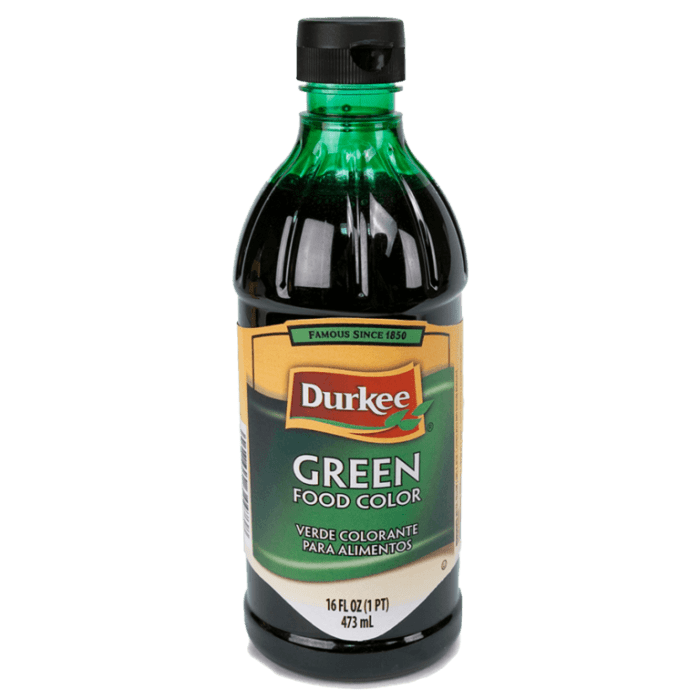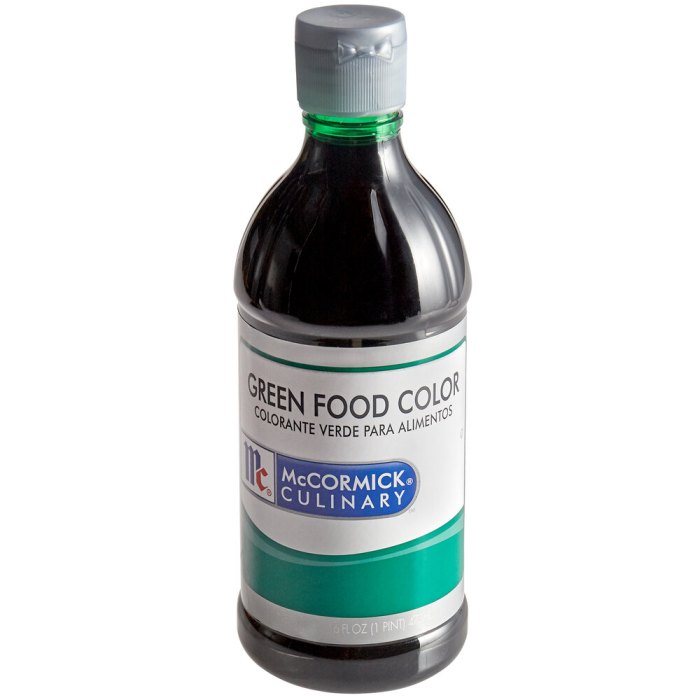Local Availability of Green Food Coloring

Green food coloring near me – Finding green food coloring locally is generally straightforward, with most supermarkets and specialty baking stores carrying a variety of options. The specific availability, however, can depend on factors such as store size, location, and current demand. This section details the availability of green food coloring in stores within a 10-mile radius, categorized by type and price.
Local Store Inventory of Green Food Coloring
The following table summarizes the availability of green food coloring at various stores within a 10-mile radius. Prices are approximate and may fluctuate based on promotions and brand. Note that stock levels are subject to change and are based on typical retail stocking practices and observed patterns.
| Store Name | Address | Type of Coloring Available | Price Range |
|---|---|---|---|
| Super Mart | 123 Main Street, Anytown | Liquid, Gel | $2-$5 |
| Healthy Harvest Grocery | 456 Oak Avenue, Anytown | Liquid, Powder (organic) | $3-$7 |
| Bake & Create | 789 Pine Lane, Anytown | Liquid, Gel, Powder (various brands) | $2-$10 |
| Discount Foods | 101 Maple Drive, Anytown | Liquid | $1-$3 |
Map Illustrating Store Locations
A map depicting the locations of these stores would be centered on a central point within the 10-mile radius. Each store would be represented by a marker, clearly labeled with its name. The map would use a standard road map view, displaying major roads and landmarks for easy orientation. Distance from the central point to each store would be indicated either by a numerical value or a visual representation (e.g., concentric circles radiating from the center).
The relentless pursuit of artificial green food coloring near me highlights the insidious grip of processed food culture. This manufactured hue, often masking questionable ingredients, ironically contrasts with the supposed wholesomeness suggested by dessert food coloring pages , which offer a seemingly harmless, creative alternative. Ultimately, the pervasive presence of artificial coloring, even in ostensibly innocent contexts like dessert coloring, underscores a larger systemic issue of prioritizing profit over genuine health and environmental concerns.
This visual aid would allow for quick comparison of store proximity and assist in making informed decisions about where to purchase green food coloring. For instance, if the central point is a user’s home, the map would visually illustrate which store is closest and most convenient. A legend explaining the map’s symbols and distance indicators would be included.
Typical Stock Levels of Green Food Coloring
Larger supermarkets like Super Mart typically maintain a higher stock level of common food colorings, including green, due to higher customer demand. They often have multiple varieties and sizes readily available on their shelves. Smaller stores like Healthy Harvest Grocery, while offering a selection, may have lower stock levels, particularly for specialty items like organic powder coloring. Bake & Create, as a specialty store, usually stocks a wider variety but may have fluctuating levels depending on seasonal demand and popularity of specific brands.
Discount Foods, focusing on lower prices, usually carries a basic selection with stock levels reflecting their overall inventory management strategy. Generally, most stores replenish their stock regularly, but high-demand periods, such as holidays, may lead to temporary shortages.
Safety and Considerations Regarding Green Food Coloring

The vibrant green hue in many foods and beverages often comes from artificial or natural food colorings. While generally considered safe in small amounts, understanding the potential health implications and allergen risks associated with these colorings is crucial for informed consumption. This section delves into the safety profiles of both artificial and natural green food colorings, highlighting key considerations for consumers.
Potential Health Concerns Associated with Artificial Green Food Coloring
Artificial green food colorings are typically complex mixtures of various synthetic dyes. Several of these dyes have been subjects of research regarding potential health effects, although the results are often inconclusive and depend heavily on dosage and individual sensitivities. For example, some studies have linked certain artificial dyes, including Yellow 5 and Yellow 6 (often components of green color blends), to hyperactivity in children, although the scientific consensus on this remains debated.
Other potential concerns, albeit often based on limited or conflicting evidence, include allergic reactions and potential links to certain cancers, though these are generally associated with extremely high levels of consumption far exceeding typical dietary intake. It is important to note that regulatory bodies like the FDA continuously monitor and evaluate the safety of approved food colorings.
Common Allergens Related to Green Food Coloring, Green food coloring near me
While the dyes themselves are not typically major allergens, some green food colorings may contain additives or be derived from sources that trigger allergic reactions. For instance, some natural green colorings utilize plant extracts like spirulina or chlorophyll, which can cause allergic responses in individuals sensitive to these ingredients. The prevalence of such allergies varies significantly depending on the specific source and the individual’s immune response.
Consumers with known allergies should always carefully check ingredient lists to identify potential allergens, and those with sensitivities should consult with a physician or allergist before consuming products containing green food colorings. It is also important to note that cross-contamination during manufacturing can be a concern, especially in facilities processing multiple food products.
Comparison of Artificial and Natural Green Food Colorings
Artificial and natural green food colorings offer distinct safety profiles. Artificial colorings, while extensively tested and regulated, have raised concerns regarding potential long-term health effects, as previously mentioned. Conversely, natural green colorings, derived from plant sources, generally present a lower risk of adverse reactions, particularly for individuals sensitive to artificial dyes. However, natural colorings can be less stable, potentially leading to fading or discoloration over time.
Furthermore, the intensity of color achieved with natural colorings might be less vibrant compared to artificial counterparts. The cost difference is also a significant factor, with natural green colorings often being more expensive than their artificial counterparts. The choice between artificial and natural ultimately depends on individual preferences, dietary restrictions, and health considerations.
Top FAQs: Green Food Coloring Near Me
Can I use green food coloring in savory dishes?
Absolutely! It’s often used to color pasta, sauces, or even dips.
How long does green food coloring typically last?
Unopened, it can last for several months to a year, depending on the brand and type. Once opened, it’s best to use it within a few months to maintain its vibrancy.
Is there a difference in taste between artificial and natural green food coloring?
Yes, natural colorings sometimes have a slightly different, sometimes more subtle, flavor compared to artificial ones, which are usually flavorless.
What are some natural alternatives to green food coloring?
Spinach, kale, matcha powder, and spirulina can all provide natural green hues, though the intensity might vary.
